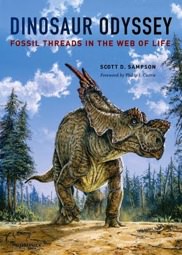Richard Ellis on Dinosaurs
A revelatory new book by Scott D. Sampson, one of our leading dinosaur paleontologists, suggests we have much to learn about extinction, global warming and energy flow from the biological experience of the charismatic beasts that roamed the Earth more than 60 million years ago.Scott D. Sampson's revelatory new book suggests we have much to learn from the charismatic beasts that roamed the Earth more than 60 million years ago.
Dinosaurs? DINOSAURS? The very word bespeaks obsolescence, inefficiency, failure to adapt to changing conditions. Isn’t Truthdig supposed to be about current events? What are dinosaurs doing in a Truthdig book review? First, “Dinosaur Odyssey: Fossil Threads in the Web of Life” is a wonderful book, crammed with information that will surprise you, especially if you thought you knew something about the thunder lizards. Because dinosaurs ruled the Earth for more than a hundred million years, compared with the measly 10,000 that Mr. Homo sapiens has been mucking up the planet, they represent one of the great success stories in evolutionary history, the diametrical opposite of obsolescence, inefficiency and failure to adapt. Moreover, unlike Mr. sapiens and his cohorts, dinosaurs left the planet pretty much as they found it; the Cretaceous asteroid impact wasn’t their doing.
Surprise No. 2: Dinosaurs never really left. They’re still here. Perhaps the most startling news item in Scott D. Sampson’s brilliant book is this: “Today, most experts agree that birds are the direct descendants of dinosaurs and thus are, in a very real sense, dinosaurs themselves.” Oh no, you say, birds have feathers. Of course they do. And so did dinosaurs. Remember Archaeopteryx, the 150-million-year-old German fossil that was long considered the first bird? It’s now been shown that the raven-sized Archaeopteryx wasn’t a bird at all, but a dinosaur. Birds have porous, light, fast-growing bones, but when researchers examined tiny chips of Archaeopteryx fossils they found dense, slow-growing bones, typical of dinosaurs. (In addition to changing Archaeopteryx into a dinosaur, they opined that it probably couldn’t fly very well either.)
Dinosaur Odyssey: Fossil Threads in the Web of Life
By Scott D. Sampson
University of California Press, 352 pages
OK, an anomaly: an early dinosaur with feathers. Big deal. Ready for another shocker? Many dinosaurs had feathers. As Sampson put it: “To date, more than a dozen different kinds of feathered nonavian dinosaurs have been found in China, and that number increases with every passing year. One of the most exciting examples is Microraptor gui, a diminutive dromaeosaur therapod bearing feathers not only on its forelimbs but on its hindlimbs as well.” In “Unearthing Dragons,” Mark Norell, curator of paleontology at the American Museum of Natural History in New York, wrote, “The feathered animals from Liaoning are some of the most unusual that anyone could ever imagine. Caudipteryx has a long, striped tail plume, a tiny head, and four small teeth at the end of its beak. Beipiaosaurus has goofy enormous forelimbs, nasty claws and strange ‘feathers’ sprouting from the backs of its arms.” Tyrannosaurus rex is scary enough (think “Jurassic Park”) without imagining a flying version, but juveniles might have had a coat of down-like proto-feathers that served as insulation. The feathered remains of an early tyrannosaurid, which lived some 130 million years ago, were unearthed in Liaoning, a region rich in fossils and the only place in the world that has yielded dinosaur fossils with feathers.
Everybody knows about the giant asteroid that slammed into the Earth 65 million years ago in the vicinity of what is now the Yucatan Peninsula and created such havoc—explosions, tsunamis, worldwide fires, acid rain, darkened skies, a halt in photosynthesis—that the dinosaurs were wiped out. Right? Well, not exactly. The evidence for the Chicxulub event is not in dispute, but the elimination of “the dinosaurs” didn’t quite happen that way. Over their 170-million-year tenure, many dinosaur species—in fact, most dinosaur species—had gone extinct long before the Cretaceous asteroid impact (the “K-T Event”), but as we can see by looking at our bird feeders, birds (which are really dinosaurs) made it through. As Sampson wrote, “With on the order of ten thousand living representative species [of birds] you could even make the argument that dinosaurs remain a thriving success story to the present day.” So dinosaurs still roam the Earth. So what?
|
To see long excerpts from “Dinosaur Odyssey,” click here. |
Sampson asks that very question in his epilogue, which he calls “Whispers from the Grave,” and answers (in italics, no less): “Dinosaurs may well be crucial to the continued existence of humanity and much of the planet’s biodiversity.” THE CONTINUED EXISTENCE OF HUMANITY? Holy velociraptor! If indeed it was an asteroid that caused all that damage to the planet 65 million years ago, maybe we ought to be thinking about what could happen to the human race in the event of a nuclear war:
“The study of the K-T ‘impact winter’ scenario—that is, the global fallout resulting from a major asteroid strike—helped define the ‘nuclear winter’ scenario—the global catastrophe that could follow an all-out exchange of thermonuclear weapons. The latter idea, presented to the U.S. Congress by such well-known scientists as Carl Sagan, has been a profound deterrent for those who might contemplate such military madness.”
Nuclear deterrence is a pretty strong justification for the study of dinosaurs, but there is, suggests Sampson, an even more persuasive reason: science. Paleontology is the science of fossil forms; creatures (and plants) that lived on Earth thousands or millions of years ago, but are now extinct. These fossils are the undisputable evidence of evolution.
Nowadays, there are those who do not believe Darwin, do not believe in fossils, do not believe in evolution. In the hill country of Kentucky (near the Cincinnati airport), you can visit the Creation Museum, whose Web site advertises “a state-of-the-art 70,000 square foot museum [that] brings the pages of the Bible to life, casting its characters and animals in dynamic form and placing them in familiar settings. Adam and Eve live in the Garden of Eden. Children play and dinosaurs roam near Eden’s Rivers. The serpent coils cunningly in the Tree of the Knowledge of Good and Evil. Majestic murals, great masterpieces brimming with pulsating colors and details, provide a backdrop for many of the settings.” The museum, which is said to have cost $27 million, is privately funded through donations to the ministry Answers in Genesis (AiG) and opened its doors to the public on May 28, 2007. Since its opening, the museum has counted more than 600,000 visitors. [One visitor among a group of paleontologists that visited the facility labeled it the “Confusion Museum.”]
The exhibits reject universal common descent, along with most other central tenets of evolution, and assert that the Earth and all of its life-forms were created 6,000 years ago over a six-day period. In particular, exhibits promote the claim that humans and dinosaurs once coexisted, and that there were dinosaurs on Noah’s Ark. The Creation Museum insists that people rode around on dinosaurs (like Fred Flintstone) and that fossils were formed when certain animals were drowned in Noah’s flood. There are as many arguments for and against creationism as there are angels that can dance on the head of a pin, but denying the prehistoric existence of dinosaurs is an insult to science and to education. Sampson writes:
“For several reasons, dinosaurs offer a superb vehicle for teaching science through a combined eco-evolutionary approach. First, unlike many topics in science, dinosaurs inspire rather than intimidate our imaginations. Second, as primary exemplars of prehistoric Earth, dinosaurs serve as able, even ideal guides to an exploration of the deep past. Third, the living descendants of dinosaurs, birds are much beloved and keenly observed, forging a robust link between past and present.”
You shouldn’t need a “reason” to read a terrific book like “Dinosaur Odyssey,” but if you need one, look out the window. City dwellers can see dinosaurs every day, although they might be no more exotic than pigeons, starlings or sparrows. (Non-urbanites might have a much greater range of possible dinosaur sightings.) Even the humble sparrow can brighten your life when you realize that its ancestry can be traced back for millions of years. Come to think of it, so can yours.
|
Richard Ellis is a celebrated marine artist and the author of more than a dozen books. He has written and illustrated articles for numerous magazines, including Audubon, National Geographic, Discover, Smithsonian, and Scientific American. His latest book is “On Thin Ice: The Changing World of the Polar Bear,” published in November. |
Independent journalism is under threat and overshadowed by heavily funded mainstream media.
You can help level the playing field. Become a member.
Your tax-deductible contribution keeps us digging beneath the headlines to give you thought-provoking, investigative reporting and analysis that unearths what's really happening- without compromise.
Give today to support our courageous, independent journalists.







You need to be a supporter to comment.
There are currently no responses to this article.
Be the first to respond.